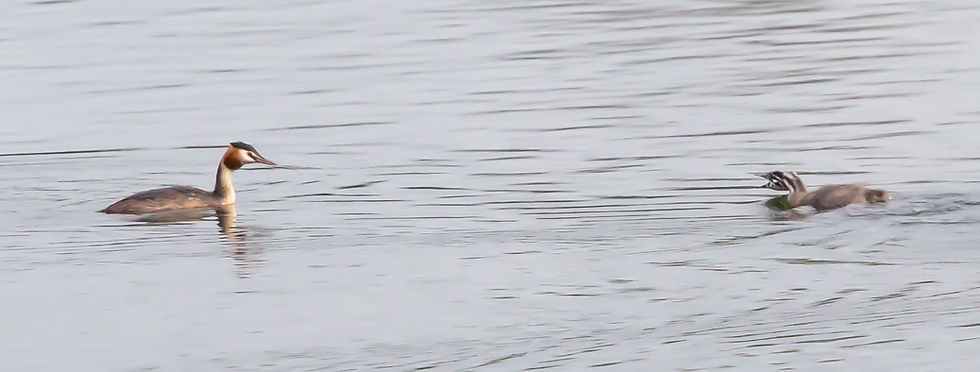Like father, like son? Well maybe not
- gileslury
- Aug 11, 2021
- 2 min read


Perhaps the two most famous major metamorphoses in nature are those by which a tadpole becomes a frog, and the transformation of caterpillar into butterfly.
Not quite on the same scale, but quite dramatic, are the changes that happen as a baby grebe, known as a grebette, grows into adulthood.
I thought of this as, on my wanderings this week, there seemed to be an abundance of grebes and their young. I thought many would no longer have been chicks as I saw and posted about baby ducks, geese and swans a few weeks ago. I was wrong, clearly; the majority of grebettes appear a little later.
Grebes or Great crested grebes, which is what I was seeing, are a type of waterbird and not a duck. They have "lobed" toes, not webbed feet. Unlike ducks, which you often see walking around, grebes are very clumsy on land because their feet are placed so far back on their bodies. You will therefore rarely see them on land and in fact I never have.
They have an elaborate courtship display or dance. A favourite of wildlife photographers, it’s a mix of diving, head shaking, and flicking of feathers and beaks. It also involving a ‘weed ballet’ where both birds dive and resurface with weeds or other greenery in their bills before they meet breast-to-breast and rear high up out of the water, paddling furiously to keep their balance. It’s an elegant, intricate affair.

They make floating nests and two eggs is the normal clutch, a reflection that both birds share parenting duties and two grebettes mean one baby for each parent to carry – something else that not surprisingly is a wildlife photographer’s favourite.


Despite the fact that young grebes are capable of swimming and diving almost at hatching, the adults will keep them close and you can often see them carrying the grebettes on their backs until they’re a bit older and bigger.

However, while I had seen and photographed some of this what struck me on this walk was the stark difference in the marking of the young and adult birds. The grebettes are a stripey black and white, reminiscent of zebras. Their beaks also seem proportionately much smaller. They don’t have the crests they will gain in later life (and which in the 19th Century nearly led to their extinction)

So all in all its quite a major transformation.
Raindrops kept falling on my head
The other thing, on this week’s walk, that ‘struck’ me ,literally, were raindrops, lots of them.
It really was ‘good weather for ducks’ though some of them didn’t really look like they were enjoying it.




And picking up on a theme I wrote about a couple of weeks ago, while in one sense quiet, there was actually quite a bit of noise as the raindrops fell onto the leaves of trees or the roofs of the hides where I took shelter every so often.
(The sharp eyed amongst you will have noticed I’ve included a couple of photos I took earlier in the year and which featured in the “Young Ones” blog but as they were relevant to this one I decided they could have a second outing)







Comments